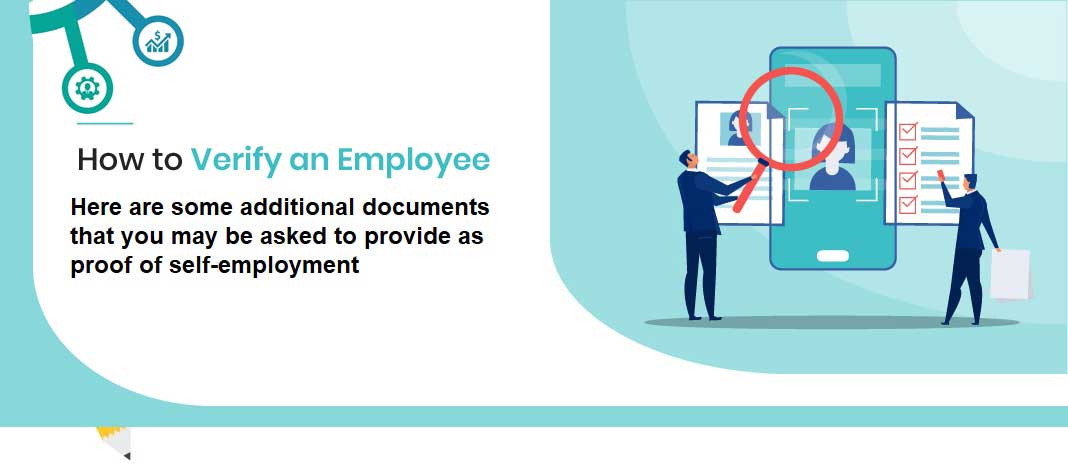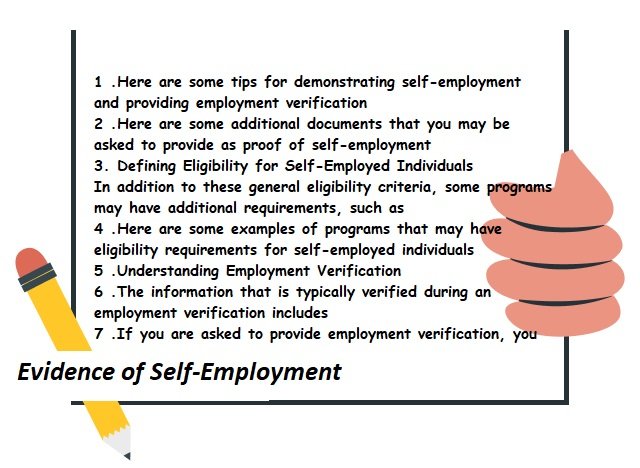Self-employment can be a great way to be your own boss and have more control over your work life. However, it can also be more difficult to demonstrate employment verification than if you were employed by a traditional company.
Here are some tips for demonstrating self-employment and providing employment verification:
- Get a business license and registration. This will give you a legal document that proves you are a legitimate business owner.
- Get a tax identification number (TIN). This is a number that the government uses to identify your business.
- Keep accurate financial records. This includes your income statements, balance sheets, and profit and loss statements.
- Get invoices from your clients. This will show that you have been providing services and that you have been paid for those services.
- Get letters of recommendation from your clients. This will provide third-party verification of your work experience and skills.
- Get a self-employment verification letter from your accountant. This letter will confirm that you are self-employed and that you have been filing taxes as a self-employed individual.
By following these tips, you can demonstrate your self-employment and provide employment verification to potential employers, lenders, and other organizations.
Here are some additional documents that you may be asked to provide as proof of self-employment:
- Bank statements: This will show your income and expenses from your business.
- Credit reports: This will show your credit history and payment history.
- Website or social media presence: This can help to demonstrate your online presence and credibility as a self-employed individual.
If you are applying for a loan or other type of financial assistance, you may also be asked to provide additional documentation, such as a business plan or financial projections.
It is important to start collecting these documents as soon as you start your self-employment journey. This will make it easier to provide employment verification when you need it.

Defining Eligibility for Self-Employed Individuals
The eligibility requirements for self-employed individuals vary depending on the program or benefit you are applying for. However, there are some general eligibility criteria that most programs will have.
- Must be self-employed: This means that you must be the owner of your own business or a freelancer who contracts with other businesses.
- Must have a certain level of income: The amount of income required will vary, but most programs will require that you have a minimum level of income in order to be eligible.
- Must have a certain level of experience: Most programs will require that you have a certain level of experience in your field in order to be eligible.
- Must be able to demonstrate your self-employment: This means that you must be able to provide documentation that proves that you are self-employed, such as a business license, tax returns, and invoices.
In addition to these general eligibility criteria, some programs may have additional requirements, such as:
- Must be a U.S. citizen or permanent resident: This is a requirement for most government programs.
- Must be in good health: This is a requirement for some health insurance programs.
- Must have a clean criminal record: This is a requirement for some programs, such as those that provide financial assistance.
It is important to carefully review the eligibility requirements for the program or benefit you are applying for in order to make sure that you meet all of the criteria.
ALSO READ:
Here are some examples of programs that may have eligibility requirements for self-employed individuals:
- Small Business Administration (SBA) loans: The SBA offers loans to small businesses, including those owned by self-employed individuals.
- Self-Employment Assistance Program (SEAP): SEAP is a program that provides financial assistance to self-employed individuals who are unemployed or underemployed.
- Medicaid: Medicaid is a health insurance program for low-income individuals and families. Self-employed individuals may be eligible for Medicaid if they meet certain income and asset requirements.
- Earned Income Tax Credit (EITC): The EITC is a tax credit for low- and moderate-income workers. Self-employed individuals may be eligible for the EITC if they meet certain income and expense requirements.
If you are self-employed and you are not sure if you are eligible for a particular program or benefit, you should contact the program or benefit administrator to inquire.
Understanding Employment Verification: What It Involves
employment verification is the process of confirming a person’s employment history and job title. It is often conducted by employers, lenders, and other organizations as part of the background check process.
There are two main types of employment verification:
- Direct verification: This involves contacting the person’s former employer directly to confirm their employment history.
- Third-party verification: This involves using a third-party company to verify the person’s employment history.
Direct verification is the most accurate method of employment verification, but it can also be the most time-consuming and expensive. Third-party verification is less accurate, but it is faster and more affordable.
The information that is typically verified during an employment verification includes:
- Name: The person’s legal name, as it appears on their employment application.
- Job title: The person’s job title at their former employer.
- Dates of employment: The dates the person was employed by their former employer.
- Salary: The person’s salary at their former employer.
- Reason for leaving: The reason the person left their former employer.
In some cases, additional information may be verified, such as the person’s performance reviews, disciplinary actions, and termination reasons.
Employment verification is an important part of the background check process. It helps to ensure that the person you are hiring is who they say they are and that they have the experience and qualifications they claim to have.
If you are asked to provide employment verification, you should be prepared to provide the following information:
- Your full name: Your legal name, as it appears on your employment application.
- Your job title: Your job title at your former employer.
- The dates you were employed at your former employer: The start and end dates of your employment.
- Your salary: Your salary at your former employer.
- The name and contact information of your former supervisor: The name and phone number of your former supervisor.
You should also be prepared to answer questions about your employment history, such as why you left your former employer and what your responsibilities were in your previous role.
If you have any questions about employment verification, you should contact your employer, lender, or other organization that is requesting the verification.
ALSO READ: A Guide to Pay Stubs for Rental Applications
Types of Proof of Employment
There are many different types of proof of employment that can be used to verify an individual’s employment status and income. Some of the most common types of proof of employment include:
- Employment verification letter: This is a letter from an employer that confirms an employee’s employment status, job title, salary, and start and end dates.
- Pay stubs: Pay stubs are a good way to document an employee’s earnings and dates of employment. They typically include the employee’s name, job title, pay rate, and deductions.
- W-2 form: The W2 form is a tax form that employers use to report an employee’s wages, withholdings, and other tax information to the IRS. It is a good way to document an employee’s income for the year.
- 1099 form: The 1099 form is a tax form that employers use to report non-employee compensation, such as freelance or contract work. It is a good way to document self-employment income.
- Bank statements: Bank statements can be used to show that an individual has a steady income. They typically show the amount of money that is deposited into the account each month, as well as any withdrawals.
- Tax returns: Tax returns can be used to show an individual’s income and expenses for the year. They are a good way to document income from all sources, including employment, self-employment, and investments.
The specific type of proof of employment that is required will vary depending on the situation. For example, a lender may require a more formal document, such as an employment verification letter, while a landlord may be satisfied with a pay stub. It is always best to check with the party requesting proof of employment to see what they specifically require.
